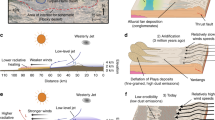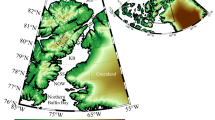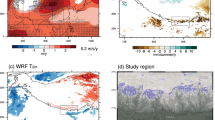Abstract
The intense radiative cooling of air over the ice slopes of Antarctica generates a surface wind regime that is strongly controlled by topography, and plays a key role in determining the behaviour of the atmosphere and ocean in high southern latitudes1–7. Resultant surface winds are intimately linked to the orientation of the ice terrain (Fig. 1) and display the highest degree of persistence found on Earth. The close coupling between wind and topography allows estimation of the former if the latter is known with some precision. Here we report on time-averaged, near-surface airflow over the Antarctic continent during winter diagnosed from a recent, accurate synthesis of terrain slopes and from estimates of the lower atmospheric temperature structure. The simulated drainage pat-tern exhibits strong spatial variability with the airflow concentrated into several zones near the coastal margin. These confluence regions are responsible for strong persistent katabatic winds over downstream coastal stretches and are indicative of zones of greatest katabatic potential.
This is a preview of subscription content, access via your institution
Access options
Subscribe to this journal
Receive 51 print issues and online access
$199.00 per year
only $3.90 per issue
Buy this article
- Purchase on Springer Link
- Instant access to full article PDF
Prices may be subject to local taxes which are calculated during checkout
Similar content being viewed by others
References
1. Egger, J. J. atmos. Sci. 42, 1859–1867 (1985). 2. James, I. N. in Second Int. Conf. on Southern Hemisphere Meteorology 117–118 (American Meteorological Society, Boston, 1986). 3. Parish, T. R. & Bromwich, D. H. Mon. Weath. Rev. 114, 849–860 (1986). 4. Polar Research Board, The Polar Regions and Climatic Change, Appendix 8–11 (National Academy Press, Washington DC, 1984). 5. Bromwich, D. H. & Kurtz, D. D. J. geophys. Res. 89, 3561–3572 (1984). 6. Zwally, H. J., Comiso, J. C. & Gordon, A. L. Antarctic Res. Ser. 43, 203–226 (1985). 7. Gill, A. E. Deep Sea Res. 20, 111–140 (1973). 8. Ball, F. K. in Antarctic Meteorology: Proc. Symp. Melbourne, Australia, 1959, 9–16 (Per–gamon, Oxford, 1960). 9. Lettau, H. H. & Schwerdtfeger, W. Antarctic J. U.S. 2, 155–158 (1967). 10. Drewry, D. J. Antarctica: Glaciological and Geophysical Folio (Scott Polar Research Institute, Cambridge, 1983). 11. Parish, T. R. Mon. Weath. Rev. 110, 84–90 (1982). 12. Schwerdtfeger, W. in World Survey of Climatology Vol. 14 (ed. Orvig, S.) 253–355 (Elsevier, Amsterdam, 1970). 13. Mather, K. B. & Miller, G. S. Notes on Topographic Factors Affecting the Surface Wind in Antarctica, with Special Reference to Katabatic Winds: and Bibliography (Geophysical Institute, University of Alaska, Fairbanks, 1967). 14. Parish, T. R. Mon. Weath. Rev. 112, 545–554 (1984). 15. Bromwich, D. H. & Kurtz, D. D. Polar Record 21, 137–146 (1982). 16. Bromwich, D. H. Antarctic}. U.S. 20, no. 5, 196–198 (1985). 17. Bromwich, D. H. in Antarctic Climate Res. No. 1 13–16 (SCAR–ACR, Antarctic Division, Kingston, Tasmania, 1986). 18. Medhurst, T. G. in ANARE Res. Notes 28 (ed. Jacka, T. H.) 174–179 (Antarctic Division, Kingston, Tasmania, 1985).
Author information
Authors and Affiliations
Rights and permissions
About this article
Cite this article
Parish, T., Bromwich, D. The surface windfield over the Antarctic ice sheets. Nature 328, 51–54 (1987). https://doi.org/10.1038/328051a0
Received:
Accepted:
Issue Date:
DOI: https://doi.org/10.1038/328051a0
This article is cited by
-
The Springtime Influence of Natural Tropical Pacific Variability on the Surface Climate of the Ross Ice Shelf, West Antarctica: Implications for Ice Shelf Thinning
Scientific Reports (2018)
-
Thermal removal of carbon dioxide from the atmosphere: energy requirements and scaling issues
Climatic Change (2018)
-
Seasonal Variations in Drag Coefficient over a Sastrugi-Covered Snowfield in Coastal East Antarctica
Boundary-Layer Meteorology (2017)
-
Present and future near-surface wind climate of Greenland from high resolution regional climate modelling
Climate Dynamics (2014)
-
Influence of persistent wind scour on the surface mass balance of Antarctica
Nature Geoscience (2013)
Comments
By submitting a comment you agree to abide by our Terms and Community Guidelines. If you find something abusive or that does not comply with our terms or guidelines please flag it as inappropriate.



